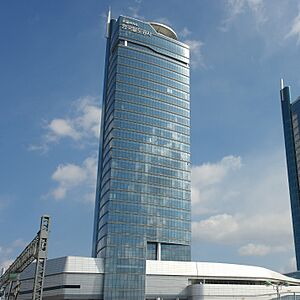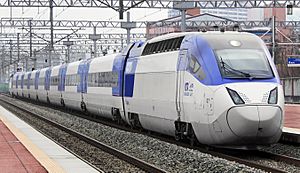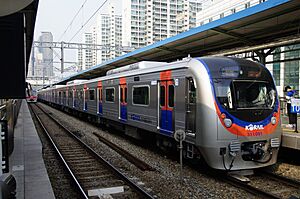Korail facts for kids

Headquarters of Korea Railroad Corporation
|
|
| Government-owned corporation | |
| Industry | Rail transport |
| Predecessor | Korean National Railroad |
| Founded | 1 September 1963 (as Korean National Railroad) 1 January 2005 (renamed as Korail) |
| Headquarters | Soje-dong, Dong-gu, Daejeon, South Korea |
| Revenue | |
|
Operating income
|
|
|
Number of employees
|
|
| Subsidiaries | SR Corporation |
| Korea Railroad | |
|---|---|
| Operation | |
| Infrastructure company | KR |
| Statistics | |
| Ridership | 969,145,101 |
| Passenger km | 31,415,965,207 |
| Freight | 10,553,675,728 ton km |
| System length | |
| Total | 4,128.6 km (2,565.4 mi) |
| Double track | 2,706.5 km (1,681.7 mi) |
| Electrified | 3,043.0 km (1,890.8 mi) |
| High-speed | 1,264.7 km (785.8 mi) |
| Track gauge | |
| Main | 1,435 mm (4 ft 8 1⁄2 in) |
| High-speed | 1,435 mm (4 ft 8 1⁄2 in) |
| Electrification | |
| AC 25,000 V 60 Hz | 3,023.8 km (1,878.9 mi) |
| DC 1,500 V | 19.2 km (11.9 mi) |
| Features | |
| No. stations | 691 |
| Highest elevation | 855 m (2,805 ft) |
| at | 37°12′0″N 128°56′59.83″E / 37.20000°N 128.9499528°E |
| Korea Railroad Corporation | |
| Hangul |
한국철도공사
|
|---|---|
| Hanja |
韓國鐵道公社
|
| Revised Romanization | Hanguk cheoldo gongsa |
| McCune–Reischauer | Han'guk ch'ŏlto kongsa |
| Korean Railroad (KORAIL) | |
| Hangul |
한국철도
|
| Hanja |
韓國鐵道
|
| Revised Romanization | Hanguk cheoldo |
| McCune–Reischauer | Han'guk ch'ŏlto |
The Korea Railroad Corporation (Korean: 한국철도공사; Hanja: 韓國鐵道公社), also known as KORAIL (코레일), is the main company that runs trains in South Korea. It is owned by the government and helps people travel and move goods across the country. KORAIL's main office is in Daejeon.
Contents
History of KORAIL
Before 1963, South Korea's trains were managed by a government office. On September 1, 1963, this office became a new agency called Korean National Railroad (KNR). In the early 2000s, the government decided to change KNR into a public company.
In 2005, KNR was split into two parts. One part became the Korea Railroad Corporation (KORAIL), which now operates all the trains. The other part, Korea National Railway (KR), is in charge of building and taking care of the railway tracks.
How KORAIL Works
KORAIL sets train ticket prices based on how far you travel. The company has faced financial challenges over the years. For example, in 2021, KORAIL had a deficit of over 1 trillion won. This means they spent more money than they earned. Train fares have not changed since 2011.
KORAIL Train Services
KORAIL offers several types of train services. These include high-speed trains, intercity trains, regional trains, and even subway-like services in big cities.
KTX: South Korea's Fastest Trains
KTX stands for Korea Train eXpress. These are KORAIL's fastest trains. KTX trains run on special high-speed lines, connecting major cities quickly. You can find KTX services on lines like the Gyeongbu HSR and Honam HSR.
ITX: Intercity Travel
ITX means Intercity Train eXpress. These trains connect cities across South Korea. The first ITX train, called ITX-Cheongchun, started running in 2012.
Before ITX, there were trains called Saemaul-ho. Many Saemaul-ho services were later updated and became part of the ITX family, known as ITX-Saemaeul. A new ITX train, called ITX-Maum, was also introduced in late 2023.
Mugunghwa-ho and Nuriro: Regional Trains
The Mugunghwa-ho and Nuriro trains are KORAIL's regional services. Mugunghwa-ho trains are named after South Korea's national flower, the hibiscus. They were once express trains but now serve more local routes.
Nuriro trains are newer and are mostly electric trains. KORAIL plans to add more Nuriro trains in the future.
Urban Railway Services
KORAIL also runs urban railway services, which are like subway lines in big cities. These services are mainly found in the Seoul Metropolitan Area and the Busan Metropolitan Area. They are connected to the local subway systems, so you can easily transfer between KORAIL lines and city subway lines.
Seoul Metropolitan Area Lines
- Line 1 connects different KORAIL lines like the Gyeongbu Line, Gyeongin Line, and Gyeongwon Line.
- Line 3 includes KORAIL's Ilsan Line.
- Line 4 connects KORAIL's Jinjeop Line, Ansan Line, and Gwacheon Line.
- There are also other important lines like the Bundang Line, Suin Line, Gyeongchun Line, Gyeongui Line, Jungang Line, Yongsan Line, and Gyeonggang Line.
Busan Metropolitan Area Lines
- The Donghae Line is part of the urban railway service in Busan.
Fun Sightseeing Trains
KORAIL has special trains just for tourists! These trains offer unique experiences and beautiful views. Some of these fun trains include the Sea Train, DMZ Train, V-Train, S-Train, A-Train, and G-Train.
Train Passes for Travelers
KORAIL offers a special pass called the Korea Rail Pass, or KR Pass, for people visiting South Korea from other countries. This pass lets them ride most KORAIL trains, including KTX, for free. However, it does not cover subway rides or tourist trains.
If you are a foreigner living in South Korea for more than six months, you can get a similar pass called the Happy Rail Pass.
Working at KORAIL
Many KORAIL employees are part of the Korean Railway Workers' Union. Sometimes, the union and KORAIL management have disagreements. Workers might protest to ask for better working conditions or pay.
KORAIL's Other Businesses
KORAIL has several companies that help with its operations:
- Korail Networks handles ticket sales and a program for frequent train riders.
- Korail Retail manages advertisements and runs "Storyway" convenience stores at stations.
- Korail Tour Service provides train staff for KTX and Saemaeul-ho trains and offers travel services.
Connecting with Other Countries
North Korea
Historically, train lines from South Korea, like the Gyeongui Line and Gyeongwon Line, used to extend into what is now North Korea. After the division of Korea, these lines were cut off.
In recent years, there have been efforts to reconnect these railway lines between North and South Korea. In 2007, test trains ran on reconnected parts of the Gyeongui Line and the Donghae Bukbu Line. Freight service started on the Gyeongui line in December 2007, connecting South Korea to the Kaesong Industrial Region in the north. This service stopped in November 2008 but resumed in November 2018.
Officials from both North and South Korea have surveyed the railway lines to plan for future connections. A groundbreaking ceremony to symbolize the reconnection of roads and railways was held in Kaesong, North Korea, in December 2018.
Japan
There are no direct railway connections between South Korea and Japan. However, a ferry service connects Busan in South Korea to Fukuoka in Japan. There have been ideas about building an undersea tunnel between the two countries, but this plan has not moved forward.
See also
 In Spanish: Korail para niños
In Spanish: Korail para niños
- List of suburban and commuter rail systems
- Korean State Railway, North Korea's national rail operator
- Daejeon Korail FC, Korea National League football team.
- Korea Rail Network Authority
- KTX Family Card, frequent riders program
- Transportation in South Korea





